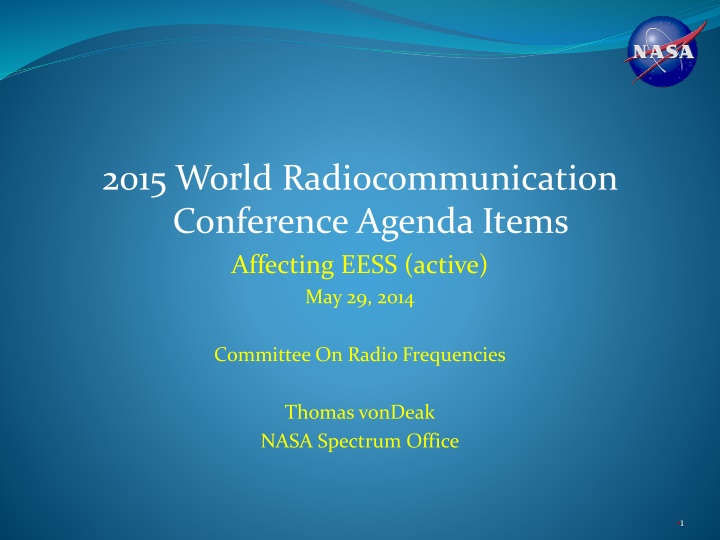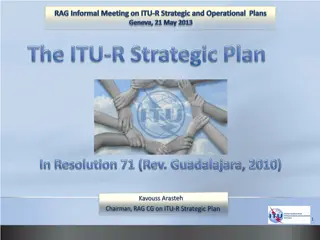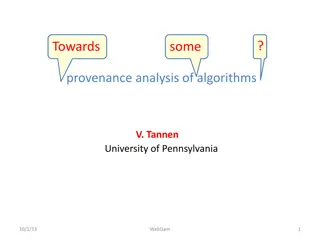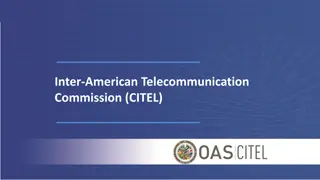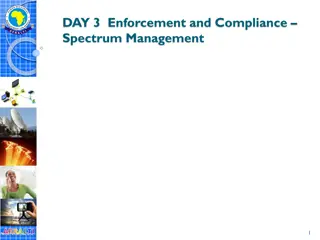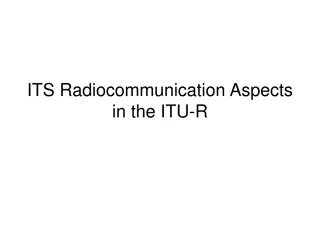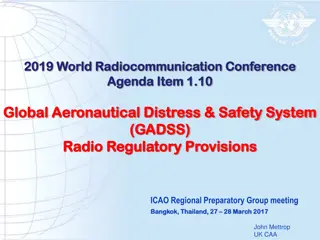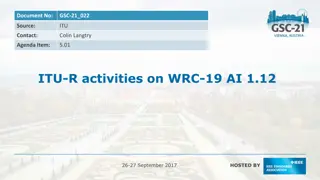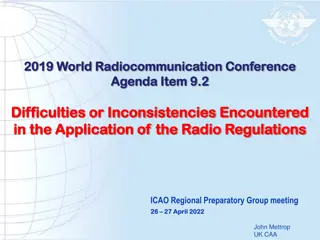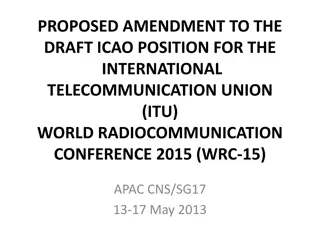2015 World Radiocommunication Conference Agenda Items
This presentation summarizes agenda items affecting EESS at the 2015 World Radiocommunication Conference, including additional mobile broadband spectrum requirements, fixed-satellite services, and extension of allocations. Mitigation techniques proposed for RLAN operations are also outlined, such as geolocation databases, dynamic frequency selection, sensors network, and image post-processing. The challenges and solutions related to the geolocation database source issues are discussed by ITU-R Working Party 7C.
Uploaded on Mar 06, 2025 | 0 Views
Download Presentation

Please find below an Image/Link to download the presentation.
The content on the website is provided AS IS for your information and personal use only. It may not be sold, licensed, or shared on other websites without obtaining consent from the author.If you encounter any issues during the download, it is possible that the publisher has removed the file from their server.
You are allowed to download the files provided on this website for personal or commercial use, subject to the condition that they are used lawfully. All files are the property of their respective owners.
The content on the website is provided AS IS for your information and personal use only. It may not be sold, licensed, or shared on other websites without obtaining consent from the author.
E N D
Presentation Transcript
2015 World Radiocommunication Conference Agenda Items Affecting EESS (active) May 29, 2014 Committee On Radio Frequencies Thomas vonDeak NASA Spectrum Office 1
Overview This presentation will provide a summary of the issues regarding the EESS (active) under these three World Radiocommunications Conference Agenda items: 1.1: Additional mobile broadband spectrum requirements including IMT and the study of potential candidate frequency bands [dc to Daylight] 1.6.1/1.6.2: Fixed-satellite service (E-s and s-E) of 250 MHz in the range between 10 GHz and 17 GHz Fixed-satellite service (E-s) of 250 MHz in Region 2 and 300 MHz in Region 3 within the range 13-17 GHz 1.12: Extension of the current worldwide allocation to the EESS (active) in the frequency band 9 300-9 900 MHz by up to 600 MHz on a primary and/or secondary basis, as appropriate, within the frequency range 8 700 9 300 MHz and/or 9 900-10 500 MHz 2
WRC-15 Agenda item 1.1 Mobile Service is seeking additional bandwidth for cellular and radio-Local Area Network (RLAN) operations. No specific frequency bands have been identified under the agenda item resolution; however, the 5 350 5 470 MHz band is under consideration for RLAN operations. The RLAN community has proposed mitigation techniques and ITU-R WP 7C has reviewed the techniques and liaised its views to ITU-R JTG 4-5-6-7. 3
Proposed Mitigation techniques The following is a list and brief description of the RLAN mitigation techniques proposed by the RLAN community. Geolocation Database A publically available global database containing the current orbital characteristics of all EESS (active) spacecraft as well as their current antenna pointing information would be accessed by the RLANs to determine when the RLANs should cease operation or move to another frequency. Dynamic Frequency Selection (DFS) RLAN detection of the EESS (active) radar when the EESS (active) spacecraft is in the vicinity. Upon detection, the RLAN would cease transmitting or switch frequency of operation. Sensors Network A distributed sensor network would be deployed by the RLAN to augment the RLAN deployment. This sensor network would provide advance information to the RLAN as to the presence of an EESS (active) spacecraft in the vicinity whereupon the RLAN would cease operation or switch frequency of operation. Image post processing Post processing of the raw EESS data will remove the RLAN interference from the underlying desired data. RLAN e.i.r.p. mask limiting RLAN implementation of an e.i.r.p. mask that would limit the power of an RLAN transmission directed towards a EESS spacecraft. In addition, other mitigation techniques are being discussed for possible consideration or a combination of the above with other TBD techniques. 4
ITU-R Working Party 7C views Geolocation Database Database source issues: No organization exists that has a database of EESS (active) sensor orbital characteristics. NORAD (U.S. Stratcomm) nor the ITU Space Networks System is comprehensive enough. Oversight concerns: Maintenance of such a database would require international overview and will have to be developed and maintained by a suitable international organisation. One size doesn t fit all: The orbital characteristics are different among different types of EESS (active) sensors (SAR, altimeters, scatterometers, ...). EESS antenna pointing: The instantaneous antenna pointing of the EESS (active) sensors is not available in any database nor is it likely to be made available by all EESS (active) operators. Many other concerns outside the expertise of WP 7C were expessed regarding this technique, such as hacking, IP tampering, and enforcement were also noted. 5
ITU-R Working Party 7C views Dynamic Frequency Selection (DFS) Latency problem: The detection would occur during an EESS (active) illumination of the area and interference to the EESS (active) would already have occurred. Regardless of the detection level used by the RLAN DFS this latency would render the technique ineffective in mitigating interference to the EESS (active) sensor. Sensors Network Non-continuous SAR operations: SAR systems do not operate in a continuous manner and so when the sensor initiate operation may immediately encounter interference under this technique. RLAN sensors in the ocean?: Measurements on coastal areas would be impacted since it is unlikely that RLAN sensors would be deployed in open water. Sensor network latency: The speed of the EESS (active) sensor (7 km/sec) would require the RLAN sensor network to be prohibitively large and details describing the coordination of the RLAN sensor network and RLAN switch operation are absent. Enforcement: Enforcement of the proper operation of the sensor network is also a concern. 6
ITU-R Working Party 7C views Image post processing Never perfect: This technique always results in a reduction of its radiometric quality. Non-universal: The post-processing algorithms under study do not work for the case of interferometric SAR measurements. Single well behaved interferer dependent: Post-processing algorithms are only be effective when the interference is from a single source generating a coherent pulsed signal . RLAN interference seen by the SAR would be the composite of many different RLAN signals from multiple RLAN devices in the SAR footprint. These devices will not generate signals that are coherent among them. RLAN e.i.r.p. mask limiting In theory an e.i.r.p. mask concept could work; however: Enforcement: Questions the means to correctly implement and enforce an e.i.r.p. mask Mass-market unlicensed devices RLAN could be ceiling mounted or mounted in different manner (e.g. wall) Multipath: Also, a mask on indoor RLAN devices would not necessarily limit emissions towards the satellite Building multipath etc. 7
Agenda item 1.6 Fixed Satellite Service (FSS) is seeking additional 250 MHz of uplink bandwidth in the frequency range of 13 - 17 GHz. Although the entire 13 - 17 GHz range is under examination only two bands are plausibly viable for consideration: 13.4 - 13.75 GHz and 14.5. - 14.8 GHz. EESS (active) operates in the 13.4 -13.75 GHz band. The results of studies performed by NASA will be provided. 8
Compatibility Analysis Input parameters Relevant system characteristics Victim receiver characteristics System noise, antenna pattern Offending Transmitter characteristics Power, antenna gain and pointing, deployment characteristics Link parameters Distance separation, shielding Evaluation Criteria Victim receiver acceptable limits of interference (Protection criteria) Amount of degradation to victim receiver signal that can be tolerated. (Interference to Noise ratio) Percentage of time the degradation can be tolerated. 9
Compatibility Analysis Methods Two basic types of analysis Single entry Dynamic analysis Systematic Random Remote Sensing System Remote Sensing System Single Fixed Satellite Service uplink Global Fixed Satellite Service uplinks 10
Compatibility Analysis Methods Single entry, static Worst case (maximum power, minimum distance), main beam to main beam coupling of the offending receiver and the victim receiver is analyzed against the evaluation criteria. RESULTS: In general, if compatibility is found through this method then compatibility is ensured. Dynamic analysis Dynamic analysis is undertaken when single entry static analysis indicates that compatibility is not ensured. Simulation of victim receiver and offending transmitter deployment using appropriate characteristics to evaluate the offending interference environment against both the amount of degradation to the victim receiver signal and the percentage of time that degradation can be tolerated. RESULTS: In general, multiple studies produce multiple results due to different simulation assumptions used. 11
Sea Surface Altimeter (SSALT) SSALTs are on JASON-1, -2(Ocean Surface Topology Mission), All spacecraft are CNES (France) missions with NASA participation; plus radiometers Launch Date: December 2001 (J1) and June 2008 (OSTM) Polar orbit at 1336 km and 66 inclination with 10 day repeat Polarization: Linear RF Center Freq: 5300, 13575 MHz RF bandwidth: 100, 320 MHz (C-band); 320 MHz (Ku-band) Pulsewidth: 105.6 sec Pulse repetition freq: 1890-2310 Hz Xmt Pwr: 16, 7 W Pk/3.9, 1.7 W Avg Chirp rate: 0.9, 3.0 MHz/ sec Transmit Duty Cycle: 24.4% This mission obtains measurements of ocean surface height using radar altimeter. OSTM is the Ocean Surface Topography Mission also known as JASON-2. 12
Precipitation Radar on GPM Global Precipitation Measurement (GPM) is a NASA/JAXA follow-on to TRMM JAXA dual frequency Precipitation Radar instrument Projected Launch Date: June 2014 Orbit at 407 km and 65 inclination Polarization: N/A RF Center Freq: 13.6 & 35.56 GHz RF bandwidth: 14 MHz Pulsewidth: 1.6 sec Pulse repetition freq: 4206 (Ku) & 4275 Hz (Ka) Xmt Pwr: 1 kW (Ku) & 140 W Pk (Ka)/6.7 W (Ku) & 0.94 W (Ka) Avg Chirp rate: 8.75 MHz/ sec Transmit Duty Cycle: 0.67% GPM concept centers on the deployment of a Core satellite carrying an advanced radar / radiometer system to measure precipitation from space and serve as a reference standard. 13
Scatterometer on ISS ISS-RapidScat Ocean Wind Monitor on International Space Station NASA JPL QuikScat replacement Projected Launch Date: June 2014 Orbit at 330-435 km and 51.65 inclination Polarization: H(inner), V(outer) RF Center Freq: 13.4 GHz RF bandwidth: .53 MHz Pulsewidth: 1 700 sec Pulse repetition freq: 180 Hz Xmt Pwr: 80 W Pk Chirp rate: 0.000311765 MHz/ sec Transmit Duty Cycle: 30.6% ISS-RapidScat will measure ocean surface wind speed and direction and help improve weather forecasts, including hurricane monitoring. 14
Altimeter Characteristics: 13.25-13.75 GHz band Altimeter Mission Sentinel-3 SRAL JASON-1/2 (OSTM) SSALT JASON-3 (OSTM) SSALT ENVISAT RA-2 HY-2A (Note 1) Altitude, km Inclination, deg Ascending Node LST* Repeat period, days Antenna Diameter Antenna Pk Xmt Gain, dBi Antenna Pk Rcv Gain, dBi Polarization Azimuth scan rate, rpm Antenna beam look angle, deg 764 98.6 10:30 35 1.2m 41.2 41.2 linear 0 0 1 336 66 NSS 10 1.2m 42 42 linear 0 0 963 99.3 06:00 14 1.4m 43 43 VV 0 0 1 336 66 NSS 10 1.2m 43.2 43.2 linear 0 0 814 98.65 22:00 27 1.2m 42 42 linear 0 0 Antenna beam azimuth angle, deg 0 0 0 0 0 Transmit Pk pwr, W e.i.r.p. peak, dBW Antenna elev. beamwidth, deg Antenna az. beamwidth, deg RF Center Frequency, MHz RF bandwidth, MHz Pulsewidth, sec Transmit Ave. pwr, W 60 59.0 1.2 1.2 13575 320,80,20 20 2.16 25 56 1.27 1.27 13.575 320 106 5.46 20 56.0 0.9 0.9 13.580 20, 80, 320 102.4 8.2 25 56 1.27 1.27 13.575 320 106.0 5.41 7.1 50.5 1.27 1.27 13 575 350 49 0.66 1 924 (LRM) Pulse Repetition Frequency (PRF) Hz 1795.33 2 060 1 000-4 000 2060 - 17 825 (SAR mode) 16, 4, 1 3.02 0.2, 0.78, 3.12 3.02 7.14 Chirp rate, MHz/ sec Transmit duty cycle, % e.i.r.p. ave, dBW System Noise figure, dB 3.6 44.5 2.5 , 3.0 21.84 49.37 2.81 40.96 52.1 [ ] 21.63 49.33 2.6 1.35-2.65, 9.31 40.2 3.1 15
Scatterometer Characteristics: 13.25-13.75 GHz band Scatterometer Mission QUICKSCAT SEAWINDS FY-3E WindRadar RapidScat HY-2A OCEANSAT-2 Scatsat-1 Meteor-M 415 51.65 [ ] [ ] .75 38 38 Altitude, km Inclination, deg Ascending Node LST Repeat period, days 803 98.6 06:00 4 963 99.3 06:00 14 720 98.28 12:00 2 720 98.28 [ ] 2 [ ] [ ] 836 [ ] 18:00 [ ] 06:00 [ ] Antenna Diameter 1m 1.3m 1m [ ] [ ] 1.4m x 0.2m Antenna Pk Xmt Gain, dBi Antenna Pk Rcv Gain, dBi 41 41 42 42 [ ] [ ] [ ] [ ] [ ] [ ] 37.5 37.5 H (inner), V (outer) 18 H (inner), V (outer) Polarization HH, VV HH, VV [ ] [ ] HH,VV 18 Azimuth scan rate, rpm [ ] 21.14 [ ] [ ] [ ] 43.63 (HH), 49.09 (VV) 45,50.5 Antenna beam look angle, deg 40, 46 [ ] [ ] [ ] 32-38 0-360 Antenna beam azimuth angle, deg 0-360 [ ] [ ] [ ] [ ] 0-360 80 57 Transmit Pk pwr, W e.i.r.p. peak, dBW 100 61.0 120 62.8 [ ] [ ] [ ] [ ] [ ] [ ] 140 [ ] 2.4/2.2 2.1 13.4 0.53 1 700 [ ] Antenna elev. beamwidth, deg 1.6 1 1.67 [ ] [ ] 6 Antenna az. beamwidth, deg 1.6 1 1.47 [ ] [ ] 0.8 RF Center Frequency, MHz 13.402 13.255.5 13.515 13.515 13.500 13 350 RF bandwidth, MHz Pulsewidth, sec Transmit Ave. pwr, W 0.53 1 700 30.6 3-6 0.4 1 350 [ ] [ ] [ ] [ ] [ ] [ ] [ ] [ ] [ ] [ ] 650-1200 28.8 180 Pulse Repetition Frequency (PRF) Hz 180 100-200 200 [ ] [ ] [ ] 0.000311765 30.6 [ ] 3.4 dB 0.000311765 30.6 55.9 3.4 0.005 24 56.6 [ ] [ ] [ ] [ ] [ ] [ ] [ ] [ ] [ ] [ ] [ ] [ ] [ ] [ ] [ ] [ ] [ ] Chirp rate, MHz/ sec Transmit duty cycle, % e.i.r.p. ave, dBW System Noise figure, dB NOTE: RapidScat is a payload on the International Space Station. 16
Precipitation Radar Characteristics: 13.25-13.75 GHz band Precipitation radar Mission CPM PMR2 TRMM PR CPM PMR GPM DPR 400/6001 50 NSS Altitude, km Inclination, deg Ascending Node LST* Repeat period, days Antenna Diameter Antenna Pk Xmt Gain, dBi Antenna Pk Rcv Gain, dBi Polarization Azimuth scan rate, rpm Antenna beam look angle, deg Antenna beam azimuth angle, deg Transmit Pk pwr, W e.i.r.p. peak, dBW Antenna elev. beamwidth, deg Antenna az. beamwidth, deg 350 35 NSS 23 2.1m 47.7 47.7 H 0.197 0-17 0-17 578 75.3 0.71 0.71 410 [ ] NSS [ ] 2m 47 47 HH [ ] 20 0 1 000 [ ] 0.7 0.7 407 65 NSS [ ] 1.6m 47.4 47.4 [ ] [ ] 17 0 1 000 77.4 0.7 0.7 5.3m 55 55 HH,HV 31 0 [ ] [ ] 0.28 0.28 13.7963, 13.802 RF Center Frequency, MHz 13 650 13.600 13.6 Number of Beams RF bandwidth, MHz Pulsewidth, sec Transmit Ave. pwr, W [ ] 0.6 [ ] [ ] 1.6 [ ] [ ] 14 1.6 6.7 4 8x4 40 [ ] 1.60, 1.60 2.57 Pulse Repetition Frequency (PRF) Hz 2776 [ ] 4 206 [ ] ** 0.44 51.8 5.5 [ ] [ ] [ ] [ ] 8.75 0.67 55.7 [ ] [ ] [ ] [ ] 3.5 Chirp rate, MHz/ sec Transmit duty cycle, % e.i.r.p. ave, dBW System Noise figure, dB 17
Evaluation Criteria Recommendation ITU-R RS.1166-4 Performance and interference criteria for active spaceborne sensors Recommends 2 that the interference and data availability criteria given in Table 2 be applied for instruments used for active sensing of the Earth s land, oceans and atmosphere. TABLE 2 Data availability criteria (%) Interference criteria Sensor type I/N (dB) 6 3 Performance degradation Systematic Random 10% degradation of standard deviation of pixel power 4% degradation in height noise 8% degradation in measurement of normalized radar backscatter to deduce wind speeds 7% increase in minimum rainfall rate 10% degradation in minimum cloud reflectivity Synthetic aperture radar Altimeter 99 99 95 95 Scatterometer 5 99 95 Precipitation radar Cloud profile radar NOTES: - Altimeter, Scatterometer, and Precipitation Radar operate in the 13.25-13.75 GHz band. Synthetic aperture radar and cloud profile radar do not operate in this band. - Systematic data availability is in regards to the data availability of a particular measurement area of interest. - Random data availability is in regards to the overall data availability; that is, the availability over the repeat period of the sensor. - Systematic data availability criteria doesn t apply to precipitation radar. 10 10 N/A 99 99.8 95 18
Analysis Results Static Analysis: Worst case analysis: main-beam-to-main-beam coupling of the FSS (E-s) transmitter and the EESS (active) receiver RESULTS: Emissions of the FSS (E-s) exceed the interference threshold criteria for all three EESS (active) sensors considered. Dynamic Analysis (random data avail. criteria) Parametric analysis conducted over the EESS (active) repeat period. Global FSS (E-s) deployment density varied from 1 (current) to 5 (worst case future). RESULTS: Compatibility is achieved for a FSS deployment density of 1 to 3. 19
Analysis Results Dynamic Analysis (systematic data avail. criteria) Evaluation of interference to a specific measurement area of interest. Using the USDA reservoir and lake monitoring program as a model, parametric studies were conducted varying the measurement area size, and the latitude deployment. RESULTS: Single earth station uplinks would exceed the systematic data availability criteria. Small earth stations would exceed over the range of +/- 10 degrees latitude. Large earth stations would exceed over the range of +/- 45 latitude. 20
Agenda item 1.12 EESS (active) is seeking an additional 600 MHz adjacent to the 9 300 -9 900 MHz band. This will enable high resolution SAR imagery and improve resistance to interference and weather. Draft CPM Report text completed by ITU-R WP 7C at its May, 2014 meeting Three methods have been put forward to address the agenda item. All methods have the following conditions: The three methods will be summarized. 21
AI 1.12 Methods All three methods have the following conditions: Systems operating in the new EESS (active) allocation would not cause harmful interference to nor claim protection from radars in the radio determination service. The use of the extension band would be limited to EESS (active) systems requiring a bandwidth of more than 600 MHz. Radio astronomy would be protected by a Recommendation incorporated by reference into the Radio Regulations. 22
Methods A1 and A2 A1: Add a primary allocation to EESS (active) in the frequency band 9 900 10 500 MHz. Subject to the three conditions. A2: Add a primary allocation to EESS (active) in the frequency band 9 900 10 500 MHz subject to inclusion of technical and regulatory constraints into the RRs. Subject to the three conditions. The protection of the Fixed Service (terrestrial microwave links) is to be ensured through a footnote in the RR with a pfd-limit. 23
Method B Primary EESS (active) allocation in the frequency bands 9 200 9 300 MHz and 9 900 10 400 MHz. Subject to the three conditions NASA prefers this method as the new allocation would be further away from the Deep Space (space- Earth) allocation in the 8 400 8 450 MHz band. 24
FINI 25
